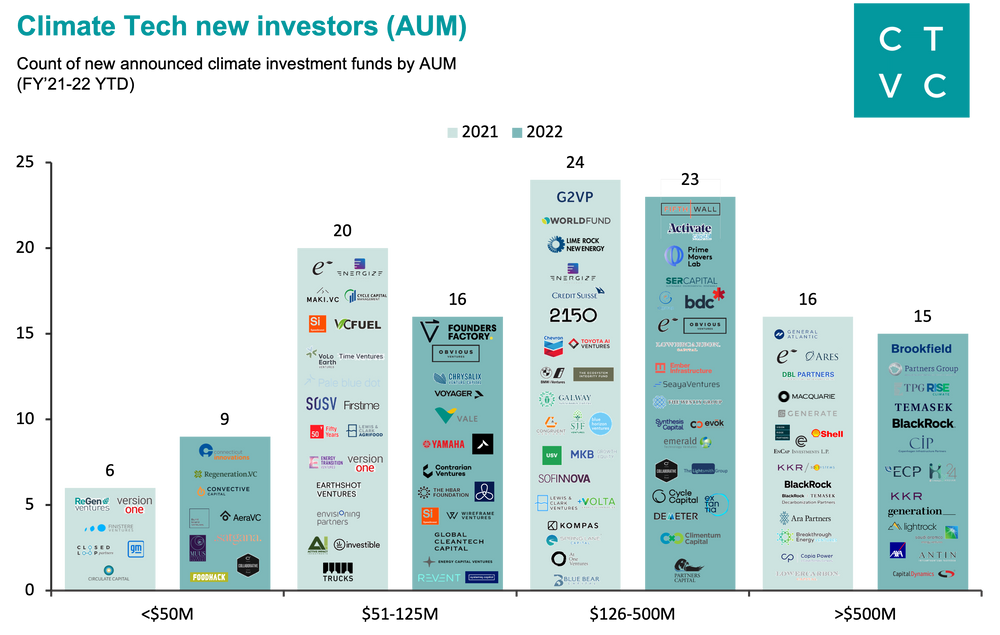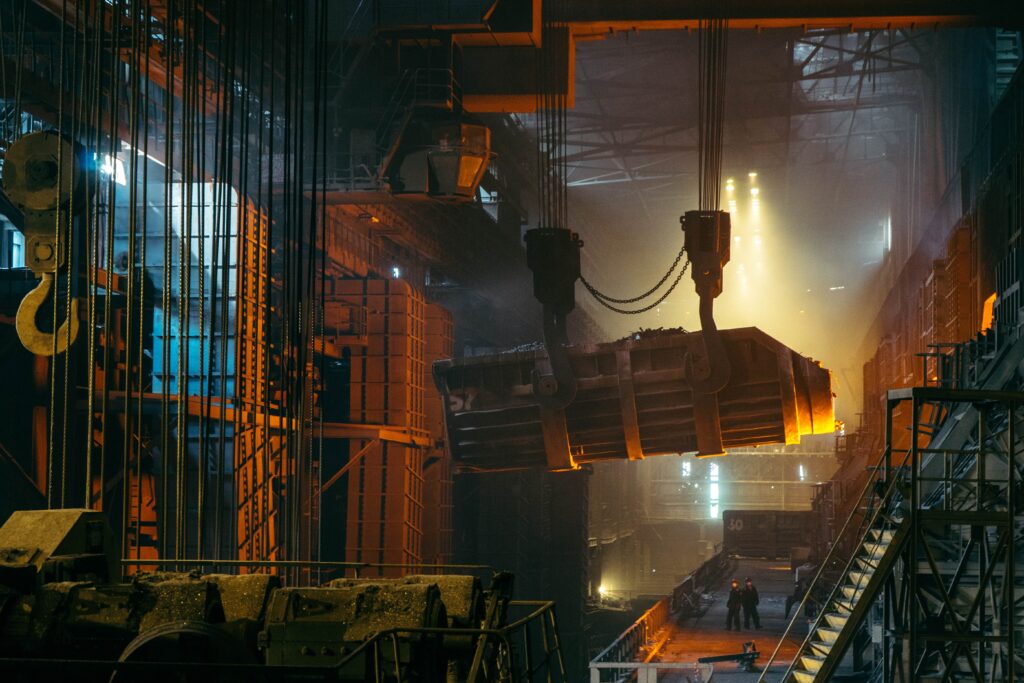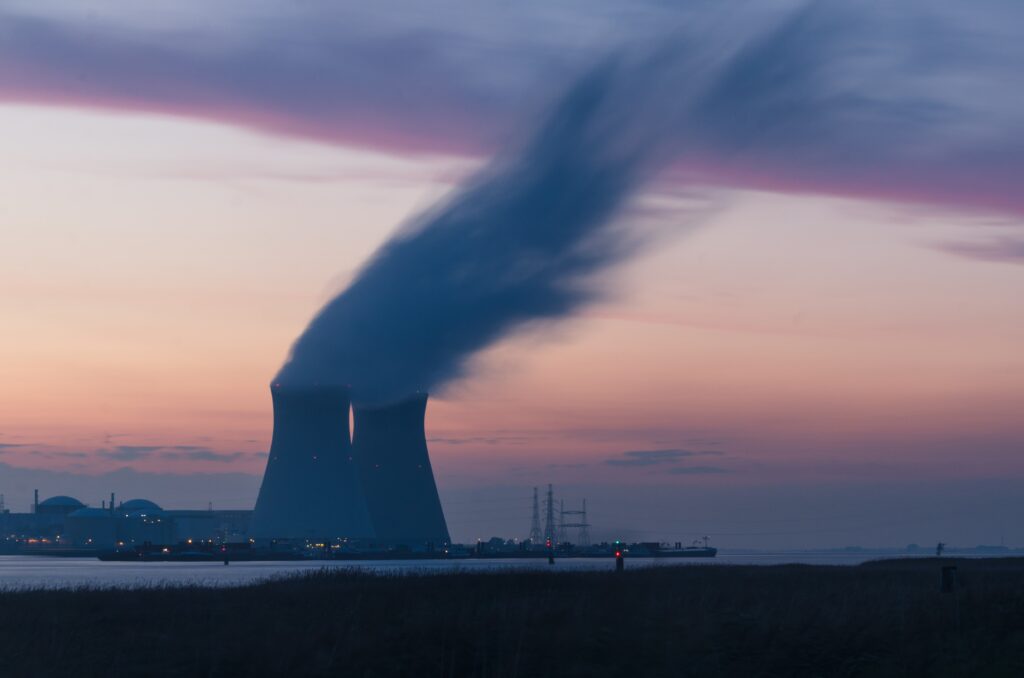22 November 2022 | Climate Tech
Giving thanks
By
This year has given us plenty of reason for pause.
Russia brazenly invaded Ukraine in late February. This conflict has disrupted energy markets significantly. As a result, Europe has seen some setbacks to its climate goals and energy independence. Perhaps nowhere is this more obvious than in Germany, where coal now regularly represents 30%+ of its grid mix.
In part exacerbated by Russia’s invasion of Ukraine, inflation has also gripped the global economy. Combined with a whole host of other macroeconomic inputs, recessionary fears, and several high-profile start-up failures have compressed multiples in public markets. With public equities taking it on the chin, private market fundraising has also taken a hit. While climate tech as a sector remains one of the most resilient, all investors and operators I’ve talked to recently noted it’s harder to raise money right now.

Further, the elephant in the room (climate change itself) grows and looms larger with every passing month. Global greenhouse gas emissions continue to rise. And countries’ enhanced focus on energy security this year in light of Russia’s invasion of Ukraine has led to expansions of coal-fired capacity, extreme demand for natural gas, and the construction of new, long-term fossil fuel infrastructure. If someone elsewhere has deluded you into thinking the world will quit fossil fuels anytime soon, I’m sorry to report that they’re here to stay for a while.
Stark opening? All that said, there’s a ton to be optimistic about. I’m pretty thankful for what 2022 has meant for climate on the whole. Here are five reasons why I’m still optimistic:
From laggard to leader
This time last year, the U.S. wasn’t making sufficiently aggressive investments, lest taking decisive action, to act as a global climate leader. With more than $500B in spending greenlit this year nationally, countless sector-specific initiatives spanning synthetic biology to long-duration energy storage, and other significant legislative progress, 2022 saw the U.S. right the ship.
Perhaps most important was the passage of the Inflation Reduction Act, a $369B spending bill for energy, climate technologies, and other environmental restoration and environmental justice efforts. Other bills, like the CHIPS Act, as well as $54B in spending on climate tech and environmental measures from California’s state legislature, carried total spending figures much higher.

We’ve seen the impact of this spending already throughout the year. Countless companies are investing in new factories, onshoring critical components of climate tech supply chains. A burgeoning example is the new ‘Battery Belt,’ a loose coalition of states, including the old.
Rust Belt, where EV battery manufacturing plants are now popping up left and right.
Perhaps most importantly, it’s far too early to tell what the U.S. taking up the helm as a leader on climate will mean for the rest of the world’s efforts. This year’s COP27 was a disappointment. But even though it feels like old news, the IRA became law less than half a year ago. Hopefully, U.S. leadership will catalyze more copycats before the decade is over.
Of course, public spending alone isn’t enough to supercharge the energy transition. Other legislative changes, such as permitting reform to make it cheaper and faster to develop renewable energy in the U.S., wait in the wings. Further, cooperation between countries is perhaps the most critical lever of all. China manufactures 80-90% of different solar panel components. Whether détente between super-emitters can turn into coordination on climate solutions is TBD.
It’s good to be a climate company
Another underappreciated benefit of public spending is that it catalyzes even more investment from the private sector. In an ideal world, the public sector paves a path for operators and investors. This dynamic is starting domestically. Climate tech and energy businesses have an enhanced line of sight with the IRA in place. Who knows how challenging the investment environment would be for earlier and growth-stage climate tech companies were it not for that legislation. Here’s how Dandelion Energy CEO Michael Sachse put it:
Overall the IRA gives our customers and us a lot of certainty going forward.
Companies like Dandelion thus have an easier time scaling their businesses and impact, even in a challenging economic environment where material and supply chain issues continue to slow deployments. As we noted on Sunday, Dandelion Energy says it has more than tripled its commercial operations this year. And they just secured more financing to expand even further. And that’s before much of the IRA’sIRA’s support has even kicked in!
A similar growth story holds for many renewable energy companies in the U.S. and other climate techs that benefit directly from new legislation. Anecdotally, I was at the bar on Friday night with a friend who’s transitioning his job to renewable energy development and said he has more interviews and interest than he can manage.
New private sector funds for climate tech continue to pop up while existing players expand and raise new funds. Venture funds are sitting on more than $300B in ”dry powder’‘ to deploy to businesses that include climate-positive prerogatives in their value proposition.

This analysis has focused on the U.S. Europe remains a bastion of sustainability and climate tech investment, having started playing a leadership role well before the U.S. was paying attention. But I’d be remiss if I didn’t acknowledge that the current energy crisis there has forced countries to take a two steps forward, one-step-back approach at the national level. A focus on decarbonization and energy transition remains for decades ahead, but keeping the lights on (and factories operating) always takes precedent short-term. And now there’s concern their policy will lag that of the U.S., too.
Still, the private sector in Europe remains ripe with climate tech founders, operators, and investors. And whether you’re in the U.S., Europe, or elsewhere, there’s another reason there’s never been a better time to start a business in climate tech or energy – talent. There’s a wave of climate-conscious folks keen to work in the new climate economy, especially tech talent.
In the past, stock-based comp from Google or Microsoft was hard to compete with. Now? Whether by way of layoffs or altruism, contributing to a greater good seems to resonate more than it did even five years ago. Nor is this just about software engineers and PMs. I’ve met plenty of mechanical and chemical engineers this year who show up to events and respond to newsletters expressing their desire to work on climate.
When I started Keep Cool two years ago, financial and human capital were the primary gap for most founders I talked to. Both still loom large for any company (they always do), but the outlook for both is better than it was in 2019 and 2020, when momentum was first picking up.
Physics and chemistry and stuff
More reason to be hopeful and thankful! The category that I often feel least qualified to write up… namely the actual physics, chemistry, and all that stuff that makes all the stuff around us work. There have been a whole host of breakthroughs in science and technology across practically every industry as part of efforts to develop a new climate economy.
The following includes but a handful of breakthroughs. I’d love you all to add your favorites that might not be mentioned. Maybe we can crowdsource a longer article for the end of the year!
No climate topic has been discussed more this year than good ol’ energy. 80% of primary energy globally still comes from fossil fuels. That needs to change. Solar and wind are making inroads while hydropower reliably chugs along. But countless innovators are ‘laser’-focused on other potential energy sources ranging from proven but technically challenging ones like geothermal to nuclear fusion, which is the stuff of space wizardry. These potential energy sources are attractive because they could feature relatively high-capacity factors like nuclear fission.
We’ve written about the amount of attention and investment fusion is garnering. And this hasn’t all been for naught; many labs and companies exploring fusion have made significant progress this year. No one has successfully generated net energy from a fusion reaction (as far as we know, many firms are tight-lipped), but researchers and companies have made significant progress towards breakeven and self-sustaining reactions.
One important step is generating high heats contained within plasma for fusion reactions (h/t to Survival Tech for the below list):
- KSTAR (South Korea) achieved a fusion reaction for 30 seconds, at temps of 100M+ °C (September, 2022).
- JET Laboratory produced 59+ megajoules from a fusion reaction. (February, 2022)
- EAST (China) sustained a nuclear fusion reaction for 17 minutes (supposedly) at ~70M °C (January, 2022)
- Lawrence Livermore National Laboratory’s National Ignition Facility achieved 1.3 megajoules of energy gain (threshold of fusion gain) was technically self-sustaining. (August, 2021)
Outside of energy, breakthroughs abound in industrial techniques for some of the hardest-to-abate industries. Many of these industries are intimately woven into the fabric of society around us, whether by way of materials like steel and cement that are all around us or synthetic nitrogen fertilizers that boost crop yields to support half the world’s population:

In steel (also ~7% of global emissions), Electra claims it can reduce iron from iron ore without the high heat characteristic of that industrial process. That’s a huge decarbonization opportunity.
Cement is (also ~7+% of global emissions) also notoriously hard to decarbonize because CO2 is released directly during a production phase known as ‘calcination’. That said, of the applications ‘deep tech’ climate companies are targeting, cement is widely pursued. Terra CO2 Technology, backed by Breakthrough Energy Ventures, is working on a low-carbon cement alternative that primary leverages waste products. Prometheus Materials is developing an organic biocomposite that’s similar to concrete, sans carbon emissions. Brimstone Energy is working on a novel production technique that uses carbon-free calcium silicate rock. These are just a handful of examples.
In fertilizer, (~1% of CO2 emissions and a much larger share of N2O emissions), many companies want to disrupt a 100-year-old process and make nitrogen fertilizer and ammonia without emissions (at least during production). And research is proving fruitful; earlier this year, scientists created ammonia in one of the ‘most efficient’ electrochemical reactions ever via a novel approach. Further, venture backed firms like Nitricity make fertilizer using 100% renewable inputs.
Elsewhere, battery chemistry is an area I can hardly keep up with the latest. It’s also a great example of how the world responds to constraints, namely by innovating. Earlier this year, Tesla noted more than 50% of its EVs batteries don’t have any cobalt in them. Lithium iron phosphate (LFP) batteries are now often preferred by EV OEMs for their long life and because they omit cobalt, reducing costs and concerns about human rights violations.
With similar constraints popping up in the lithium market, at the utility-scale, companies like Form Energy are commercializing other chemistries like iron-air batteries. Innovations like these also have supply chain resilience benefits; China currently has close to 60% of the world’s lithium refining capacity. On that front, countless companies are working to develop battery material supply chains elsewhere in the world.
Everywhere you look, companies are making meaningful strides and doing climate-positive work.
Attention economy
You’ve made it this far. The rest of this note is short. Here’s another important lever for climate tech and the climate: People care. There are nearly 16,000 of you signed up for this newsletter. This time last year, there were less than 1,000.
Politics and voting are imperfect litmus tests for this, but they’re more easily measurable and quantifiable. By all accounts, Gen Z and younger generations showed up in a big wayduring the U.S. midterm elections. They overwhelmingly support climate-forward causes. Elsewhere, Brazilian voters managed to turn from a climate denier to elect an Amazon-embracing candidate. And Putin’s brazen attempts to consolidate power in Eastern Europe have countries and citizens alike working to reduce dependencies on Russian fossil fuels.

People have also gotten politicians to reverse course on ill-advised policy choices. From California to Germany (both places I can call home by some measure), grassroots support and new-age influencers alike helped keep nuclear power plants open. While not a novel technology, good ol’ nuclear fission is a beast at displacing CO2 emissions. These weren’t small feats, especially because they required people to change their minds. Not something we’re always good at!
From an industry perspective, every event at climate tech NYC this year was packed, and industry vets marveled at the interest shown by job seekers, investors, and media alike. I haven’t been in this space that long myself, but by all accounts from people that have, things most certainly haven’t always been this way. Pat yourself on the back!
As we’ve highlighted throughout this email (and in this newsletter week in and week out), it’s noteworthy that people care about the business of climate and climate tech. Gone are the days of idealism, where people thought consumers could successfully agitate for necessary change by composting, recycling, and hugging trees (to be sure, I’m a fan of all those things). But when corporations’ incentives align with the planet’s flywheels start popping up everywhere. Love it or hate it, in the same way, fossil fuels are still the predominant fuel of our society, capitalism is its dominant system.
Everything else
I wouldn’t write a Thanksgiving newsletter without getting a tiny bit corny. We can talk about money, policy, and technology all we want, but subtle shifts in consciousness are also a powerful lever for change. To this end, I offer the below passages from a great book, Braiding Sweetgrass, for more perspective on giving thanks for everything around us. Many things are easy to be thankful for when we take a minute and tune in:
I greet you, jar of jam. You glass who once was sand upon the beach, washed back and forth and bathed in foam and seagull cries, but who are formed into a glass until you once again return to the sea… Even the metal of my lamp asks me to consider its roots in the strata of the earth.
And still, others are some of the most maligned in our society. Little gets a worse wrap in climate circles than plastic (coal, oil, and natural gas are probably still front runners). Still, it’s been on its own miraculous multi-million-year journey and is a critical component in life-saving innovations that range from medical devices to PPE for hospital workers:
… I notice that my eyes and my thoughts pass quickly over the plastic on my desk. I hardly give the computer a second glance… And yet I mean no disrespect for the diatoms and marine invertebrates who two hundred million years ago lived well and fell to the bottom of an ancient sea, where under great pressure of a shifting earth they became oil that was pumped from the ground to a refinery where it was broken down and then polymerized to make the case of my laptop…
If we all spent a minute every day more consciously appreciating the myriad material pathways required to create the things we hold, society would likely be much less abstracted. If we all understood the ins and outs of water sanitation better, we’d build more water reuse and recycling systems. If we knew how plastic got made and where it ends up after we use it, we’d throw less of it away. If we tracked the thousand mile journey our food often takes to our plate, we’d waste less of it.
Food for thought in addition to all the food you’ll have for Thanksgiving!